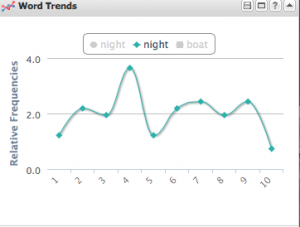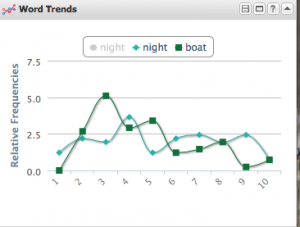During the markup process of my Linn diary transcription, I learned a lot about the context of Linn’s writings through close reading. It allowed me to focus on certain words that helped me get a greater understand of the t text as a whole. Even collaborating with the editorial group in class helped me get a better grip on how to mark up certain words. One such instance that helped me decide what to mark certain words was the debate over whether a boat is a place or an object. In my opinion, I believe a boat is a place; it is extremely the case when it is named like the “Cossack.” The “Cossack” seemed to have much more of a meaning and presence than just an object. After a lengthy and intense discussion on why our class felt what they felt, we decided to mark up any boat, regardless of a proper noun, an object. We decided that this “object” would have a more descriptive mark up.

Elena Pierazzo really categorizes the, in Jakacki’s words, “richness of the marked up text as a form of intellectual engagement with its interpretation.” In her article, “A Rationale of Digital Documentary Editions” is exemplary of how people should mark up transcriptions. One way she wants people to consider the marking up process is to have “have limits, and limits represent the boundaries within which the hermeneutic process can develop”(Pierazzo). Basically, she believes that we cannot mark up and focus on every single word. That would one, very time-consuming, and, two, counterproductive. In order to interpret Linn’s transcriptions, we had to make decisions on what was important to us. If everything was marked up, wouldn’t we just end up at the beginning? We need to see the relationship between certain things and this is, ultimately, intellectual engagement.

Another point that Pierazzo brings up is that we ultimately choose what we rant to represent. There needs to be a meaning behind the mark ups. She states that “the process of selection is inevitably an interpretative act: what we choose to represent and what we do not depends eitherr on the particular vision that we have a particular manuscript or on practical constraints”(Pierazzo). There are certain influences that make us mark up certain words. In my case, I focused on people and places. What I found was that after zoning in on one particular area, I could then go deeper and mark up those words even further. While having some technical difficulties in the level I could describe different people’s roles, I at least was trying to make that one of my main goals.
The last crucial point that Pierazzo argues is that letters are not just marks on a paper. They are symbols we chose to make meanings for. Robinson insists, “‘an ‘i’ is not an ‘i’ because it is a stroke with a dot over it. An “i” is an “i” because we alls agree that it is an ‘i’’”(Pierazzo). Taking this into consideration, our class decided that we would always use “&” for every time Linn uses “&.” After coming to this conclusion, we had to make it clear in Oxygen that we wanted “&” to also mean “and.” An ampersand is not just some weird symbol, we came to a final conclusion, along with the English society, that an ampersand means and.
After using Oxygen and reading the Pierazzo article, I really have a better understanding for Diary 60 of the Linn transcription. Close reading individual words contributes to the overall meaning of Linn’s diary.
 The first world I selected was “night.” This word appears 82 times throughout the text. As I clicked on the word in cirrus tool and viewed it on the word trends tool, I did not notice any patterns whatsoever. Especially during the time period Dr. J. addresses, there was a consistent frequency of the number of times night was used. It also did not appear to be too much different than the beginning diary transcripts, either. Distant reading using this word alone, did not help with Professor Jackacki’s research question.
The first world I selected was “night.” This word appears 82 times throughout the text. As I clicked on the word in cirrus tool and viewed it on the word trends tool, I did not notice any patterns whatsoever. Especially during the time period Dr. J. addresses, there was a consistent frequency of the number of times night was used. It also did not appear to be too much different than the beginning diary transcripts, either. Distant reading using this word alone, did not help with Professor Jackacki’s research question. However, when I added a second word, “boat,” I noticed a distinct interesting. I noticed these two trends were almost mirror images of each other. There seemed to be a negative correlation between talking about night and talking about boats. Whenever Linn was talking about a boat, typically the Cossack, he did not seem to be mentioning night. This leads me to the question: when Linn is on board the Cossack, is he writing at night, therefore he does not mention night, or does all the action seem to talk place during daylight hours? Why does is there this strange relationship between “boat” and “night”?
However, when I added a second word, “boat,” I noticed a distinct interesting. I noticed these two trends were almost mirror images of each other. There seemed to be a negative correlation between talking about night and talking about boats. Whenever Linn was talking about a boat, typically the Cossack, he did not seem to be mentioning night. This leads me to the question: when Linn is on board the Cossack, is he writing at night, therefore he does not mention night, or does all the action seem to talk place during daylight hours? Why does is there this strange relationship between “boat” and “night”?